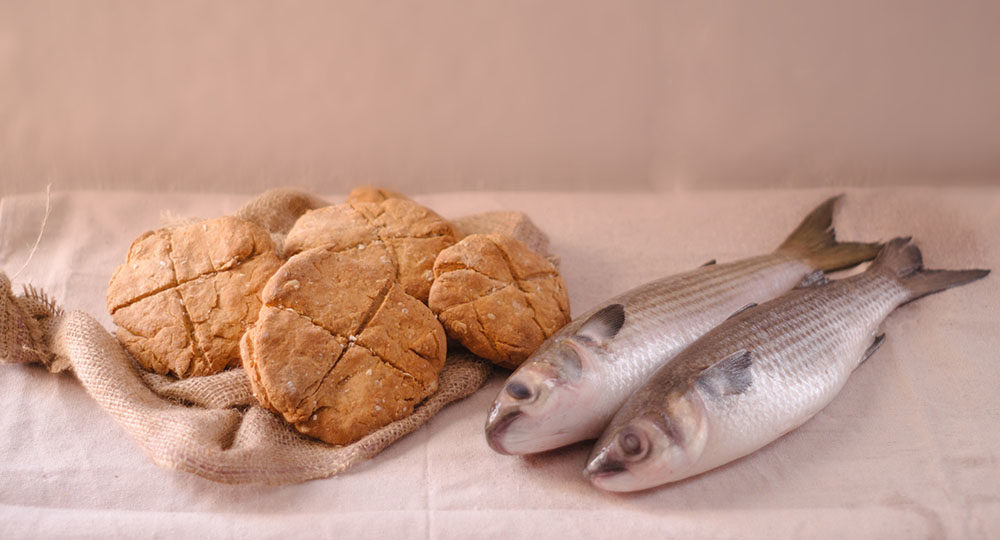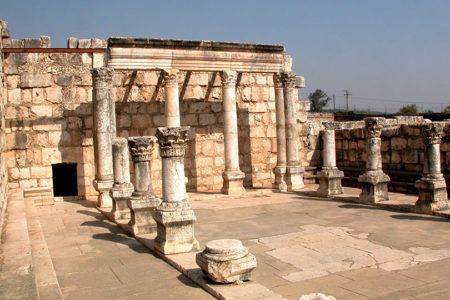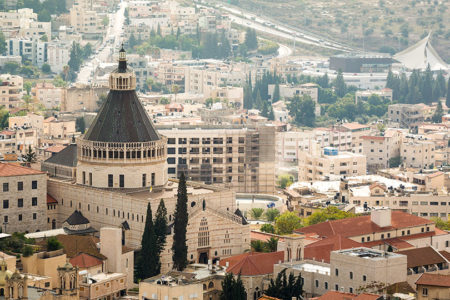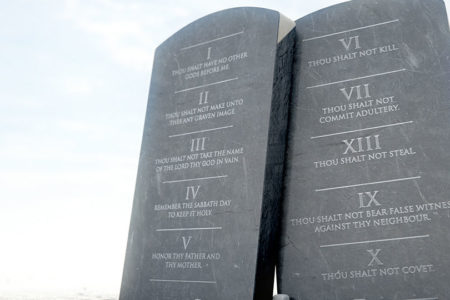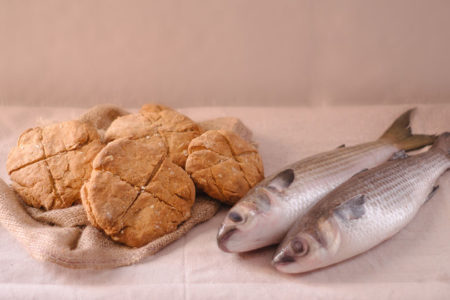Bread Enough for All
John the Baptist had boldly confronted sin in the palace of Herod. Herod had taken his brother’s wife Herodias for himself, and John was beheaded for his decrying confrontation of this sin.
On hearing of John’s death, Jesus took His disciples to a secluded place near the Sea of Galilee for some much needed rest. The death of John the Baptist set in motion a series of events that led to possibly the two best-known of Jesus’ miracles. Before we consider these two miracles that followed John’s death, let us consider his initial imprisonment and the sequence and purpose of events that followed.
The Imprisonment of John
Upon hearing that John was in prison (Mt. 4:12–13), Jesus immediately departed for Galilee. It was as if John’s circumstances were pivotal for the next stage of His ministry. Jesus left for Galilee to fulfill the prophecy of Isaiah 9:1–2 (Mt. 4:14–16). The people of the region were in spiritual darkness. Isaiah had prophesied that a great light would penetrate that darkness. That light would be Jesus and His claim to be the Messiah.
Matthew 4:23–25 states that
Jesus went about all Galilee … healing all manner of sickness and all manner of disease among the people … and they brought unto him all sick people that were taken with diverse diseases and torments, and those who were possessed with demons, and those who were epileptics, and those who had the palsy; and he healed them.
After delivering the Sermon on the Mount, recorded in Matthew 5—7, Jesus performed the majority of His miracles, which are recorded in Matthew 8—9.
Signs of the Messiah
Many Jews consider miraculous works to be necessary events in the coming of the Messiah. The miraculous works of Isaiah 35:5–6 are repeatedly applied to Messianic times. Alfred Edersheim, in his work The Life and Times of Jesus the Messiah, mentions such works as Yalkut I 78c, the Midrash commentary on Psalm 146:8, and the Midrash commentary in Genesis Rabba 95 as applying the Isaiah passage to Messianic times.
Raphael Patai in The Messiah Texts tells of several false messiahs who deceived people by promising miracles. Patai states, “the belief in these self-proclaimed Messiahs and in their power to perform miracles could be so strong that it could override all normal instincts of self-preservation.”
The late Lubavitch rebbe, Menachem Schneerson, in discussing Maimonides’ view that there will be two periods within the Era of Redemption, the coming of the Messiah, mentioned “one period associated with the coming of moshiach [Messiah], when the natural order will continue to prevail, and a subsequent period which will see miracles that depart from the natural order, including the resurrection of the dead.”
The use of miracles in conjunction with the Messiah is a concept clearly taught in Judaism. It is also the reason Jesus went to Galilee upon hearing of the plight of John the Baptist. His miraculous works would help confirm Him as the Messiah of Israel.
John spent about a year in prison under some of the worst conditions imaginable. Finally, this great man of God began to question if Jesus was really the promised one of Israel. Thus, he sent two of his disciples to ask Jesus if He was the Messiah or if they should look for another.
Jesus’ response was interesting. “Go and show John again those things which ye do hear and see: The blind receive their sight, and the lame walk, the lepers are cleansed, and the deaf hear, the dead are raised up, and the poor have the gospel preached to them” (Mt. 11:4–5). The reality of Jesus’ statement also reflects back on Isaiah 35:5–6 and 61:1–2. The authenticating mark of Jesus’ answer was that He had done many miraculous works. It was prophesied that when the Messiah came, He would do miracles. The messengers were to tell John of Jesus’ works, which authenticated His ministry as the Messiah. There was no need to look for another!
With this confirmation, John could face his coming death with the utmost confidence. The one he proclaimed and followed was indeed the promised Messiah of Israel.
Feeding of the Five Thousand
(Mt. 14:13–21; Mk. 6:30–44; Lk. 9:10–17; Jn. 6:1–14)
The miracle referred to as the feeding of the five thousand is the only miracle recorded in all four of the Gospels, which verifies the importance of this miracle.
The actual number of people fed may have been as high as 20,000 or more. The text says, “they that had eaten were about five thousand men, besides women and children” (Mt. 14:21).
After the death of John the Baptist, Jesus and His disciples retreated to a secluded place in the desert to get some sorely needed rest. But multitudes of people followed Jesus. They had seen and heard of His miracles of healing and followed Him because of the works that He had done.
The thing that motivated Jesus to come to Earth also motivated Him at this time. “Jesus, when he came out, saw many people, and was moved with compassion toward them, because they were as sheep not having a shepherd” (Mk. 6:34). Jesus’ love and compassion moved Him to minister to the people, in spite of His weariness.
As night approached, the disciples came to Jesus and suggested that He send the people away since it had been a long day, they had had no food, and none was available for such a large crowd. What took place next was an exciting pinnacle of Jesus’ miracles in authenticating His Messiahship. Andrew, Simon Peter’s brother, mentioned to Jesus that there was a young boy present who had five barley loaves and two small fishes. It was as if he were saying, “See, there is so little food; there is no way we can feed these thousands.” We can almost hear the other disciples in the background agreeing with Andrew’s obvious logic.
But the shortsightedness of the disciples was no barrier to the power and provision of the Lord. Jesus commanded the disciples to bring the small amount of food to Him and to have the people sit in orderly rows and sections. Jesus then took the five loaves of bread and two fishes, blessed them, and gave them to the disciples to distribute to the people.
How amazed the disciples must have been at what took place next. The food kept coming, and coming, and coming. It was as if the supply was inexhaustible. When everyone was fed, twelve baskets full were left, one for each disciple.
The old adage, “Little is much when God is in it,” is certainly true. The needs of the people were met through the resources of the Messiah.
We should not forget, however, the underlying principle in Jesus’ use of miracles. They were to authenticate His ministry as the Messiah. Commenting on this miracle, John 6:14 says, “Then those men, when they had seen the miracle that Jesus did, said, This is of a truth that prophet that should come into the world.”
Jesus Walks on Water
(Mt. 14:22–33; Mk. 6:45–52; Jn. 6:15–21)
Immediately after feeding the multitudes, Jesus told His disciples to get into a ship and head back to the other side of the Sea of Galilee. The reluctant disciples obeyed their Lord.
Sometime during the night, a storm with strong winds and high waves buffeted the boat. During the fourth watch—between 3 a.m. and 6 a.m.—after many hours of fighting the storm, Jesus appeared to the disciples walking on the water. Initially they were afraid, as they cried out, “It is a ghost” (Mt. 14:26). But Jesus hastened to calm them, calling out, “Be of good cheer; it is I; be not afraid” (Mt. 14:27).
At that time, Peter—ever bold, ever impetuous—said to Jesus, “Lord, if it be thou, bid me come unto thee on the water” (Mt. 14:28). “Come,” the Lord replied (Mt. 14:29).
At first, things went well for Peter, but soon the ferocity of the wind caused him to turn his gaze to the circumstances around him and away from the one who had called him to walk on the water. With his eyes turned away from Jesus, Peter began to sink. In desperation, he cried out to Jesus to save him. Immediately, Jesus caught Peter and they boarded the ship. Then the wind and the waves ceased.
This series of events astounded the disciples. Mark stated that “they were very much amazed in themselves beyond measure, and wondered” (Mk. 6:51). Because they did not consider the miracles of the previous two years, and especially the most recent miracle of the loaves and fishes, Jesus’ work surprised them. But again, this miracle authenticated the ministry of Jesus. For the first time the disciples worshiped Him, saying, “Of a truth, thou art the Son of God” (Mt. 14:33).
Confirmation Of His Ministry
These two miracles, performed after the death of John the Baptist, should have solidified in people’s minds the claims of Jesus as the Messiah. John was gone, but one greater than him was present.
The overwhelming majority of Jesus’ miracles performed before this time were of a personal nature, most involving healing people of various physical infirmities. They authenticated His Messiahship and revealed His compassion for people. But these last two miracles showed His power over the substance of the earth and the forces of the heavens. It was as if they were an emphatic exclamation mark on the authenticity of His ministry as the Messiah.
Jesus did not use miracles capriciously, but with an intended purpose—to authenticate His ministry as the Messiah. In a possibly greater way than the other miracles, the feeding of the five thousand and walking on water confirmed His claims as Messiah.
Although we would expect the coming of the Messiah to be accompanied by miracles, miracles in themselves would never convince anyone of Jesus’ Messianic claims.
The day following these two miracles, the people again came to Jesus.
Earlier they had tried to make Him king (Jn. 6:15), but He would not allow it, saying, “Verily, verily, I say unto you, Ye seek me, not because ye saw the miracles, but because ye did eat of the loaves, and were filled” (Jn. 6:26).
In Matthew 16:1–4, some of the Pharisees and Sadducees came to Jesus requesting a sign from heaven. The hypocrisy of their request was self-evident. A multitude of signs and miracles had already been performed, but they did not believe in Him, nor would they be convinced by another sign. Jesus said, “A wicked and adulterous generation seeketh after a sign” (Mt. 16:4).
Although miracles were an indispensable part of the confirmation of Jesus’ claim to being the Messiah, they alone were impotent. Many false Christs and leaders of other religions have worked “miracles” through the centuries.
Jesus was set apart as the true Messiah not only by the confirming miracles but by His impeccable credentials. Matthew, for example, initially showed his readers that Jesus was the one who came in fulfillment of the Messianic prophecies. In the first two chapters, he confirmed that Jesus fulfilled not only the necessary lineage of the Messiah, but the prophesied place of His birth, the manner of His birth, and the time of His birth. Jesus alone fulfilled the scores of prophecies about the Messiah.
Many lessons can be learned from these two miracles. They remind believers that “God shall supply all your need according to his riches in glory by Christ Jesus” (Phil. 4:19). They also remind us that faith is the key to a victorious life (Heb. 11:1–6; 2 Pet. 1:1–12).
The basic lesson of these miracles, however, is that Jesus is who He claimed to be: the Messiah of Israel and the God of the universe. He is worthy of our belief and worship.
